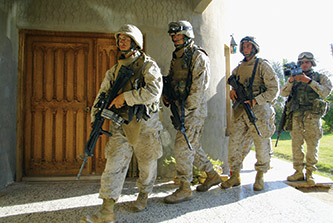History: Optics of War
Since the opening days of the Iraq War in 2003, scholars have examined the United States military from many angles. In his latest project, historian John Pettegrew examines the way that visual culture within the United States Marine Corps facilitates the projection of force in foreign wars—in particular, in the Iraq War.
The author of the upcoming book U.S. Marines and the Optics of Combat in the Iraq War, Pettegrew focuses on how the United States is able to get military force into a foreign country to wage war. He argues that warfare has a 21st-century appeal to young men, developed through a visual culture and training that facilitates war making and mass violence. It facilitates war making by appealing to the eye, by creating visual representations of combat—in movies, YouTube and first-person shooter combat video games—that make causing death and destruction look pleasurable, challenging and gratifying.
“The killer distances himself from the killed through technology, which is not a new story,” says Pettegrew, associate professor of history and director of American studies. “It’s been around since the invention of the longbow. But that technology enjoyed a huge advancement in the years leading up to the Iraq and Afghanistan wars through the digital revolution and network-centric, mobile warfare.”
Pettegrew examined more than 100 oral histories of Marines held at Quantico, Va. Quantico is home to the Corps’ library and archives, and Pettegrew was granted access to hundreds of hours of video and audio files.
“I experienced considerable cooperation from the Marine Corps. They opened up a lot of their material to me, including interviews they conducted with their own people who were on the ground in the opening months of the war in Iraq.”
Pettegrew found many of these men were influenced by first-person combat video games and YouTube war videos. The first wave of Marines into Iraq were well equipped with personal cameras and they captured images of their firefights. Pettegrew spent three months watching videos created by Marines and examining the comments posted by viewers. From that work, he found patterns in the responses. The videos glorify combat, he says, while separating the viewer from the victim’s humanity.
Posted on:


